Next Retail Fashion Store assignment PDF
VerifiedAdded on 2021/05/31
|10
|1981
|22
AI Summary
Contribute Materials
Your contribution can guide someone’s learning journey. Share your
documents today.

Test Plan for the Next Retail Fashion Store Cloud Based BPM System
Date
Version :
Created:
Last Revision:
Status:
Date
Version :
Created:
Last Revision:
Status:
Secure Best Marks with AI Grader
Need help grading? Try our AI Grader for instant feedback on your assignments.
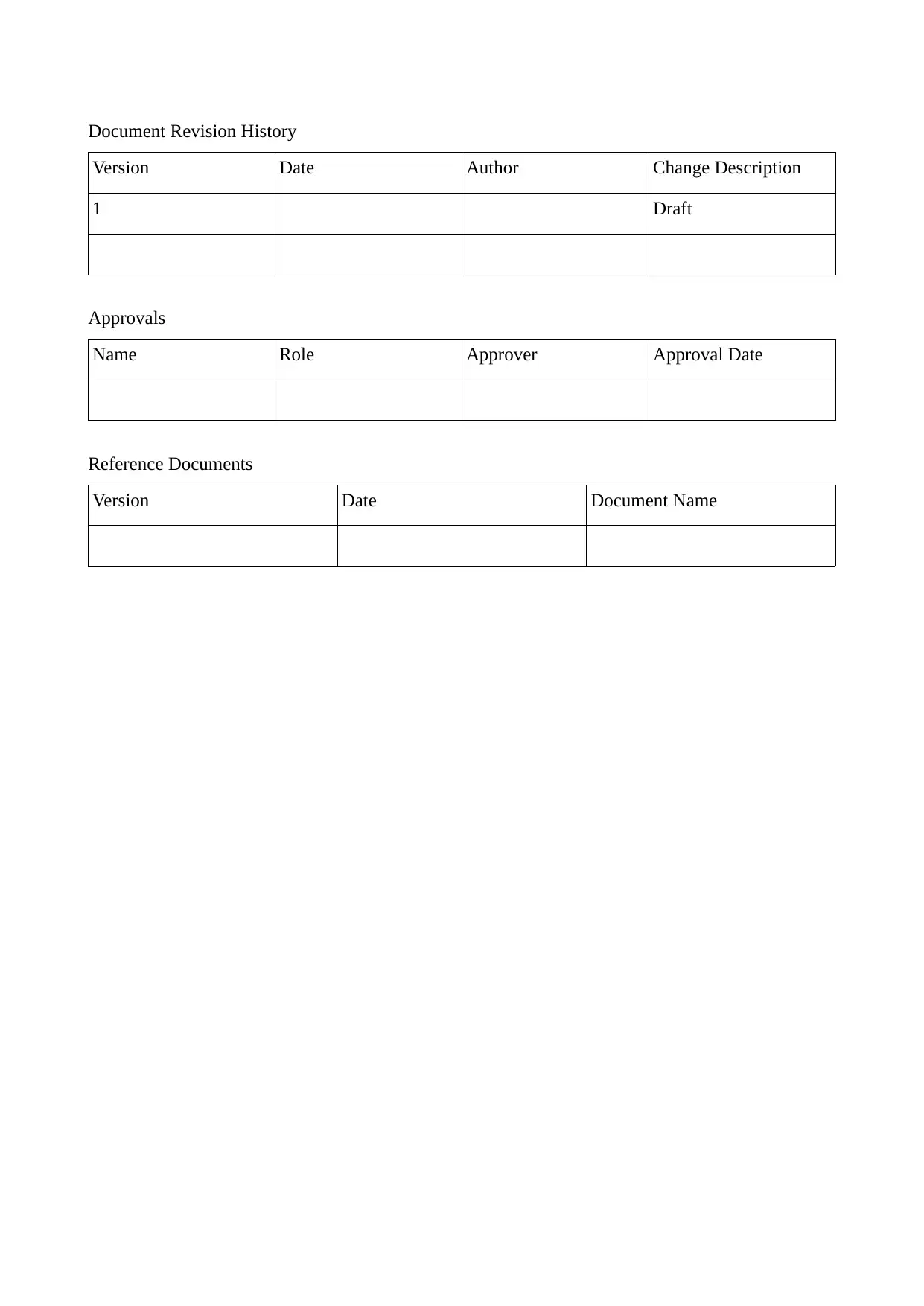
Document Revision History
Version Date Author Change Description
1 Draft
Approvals
Name Role Approver Approval Date
Reference Documents
Version Date Document Name
Version Date Author Change Description
1 Draft
Approvals
Name Role Approver Approval Date
Reference Documents
Version Date Document Name
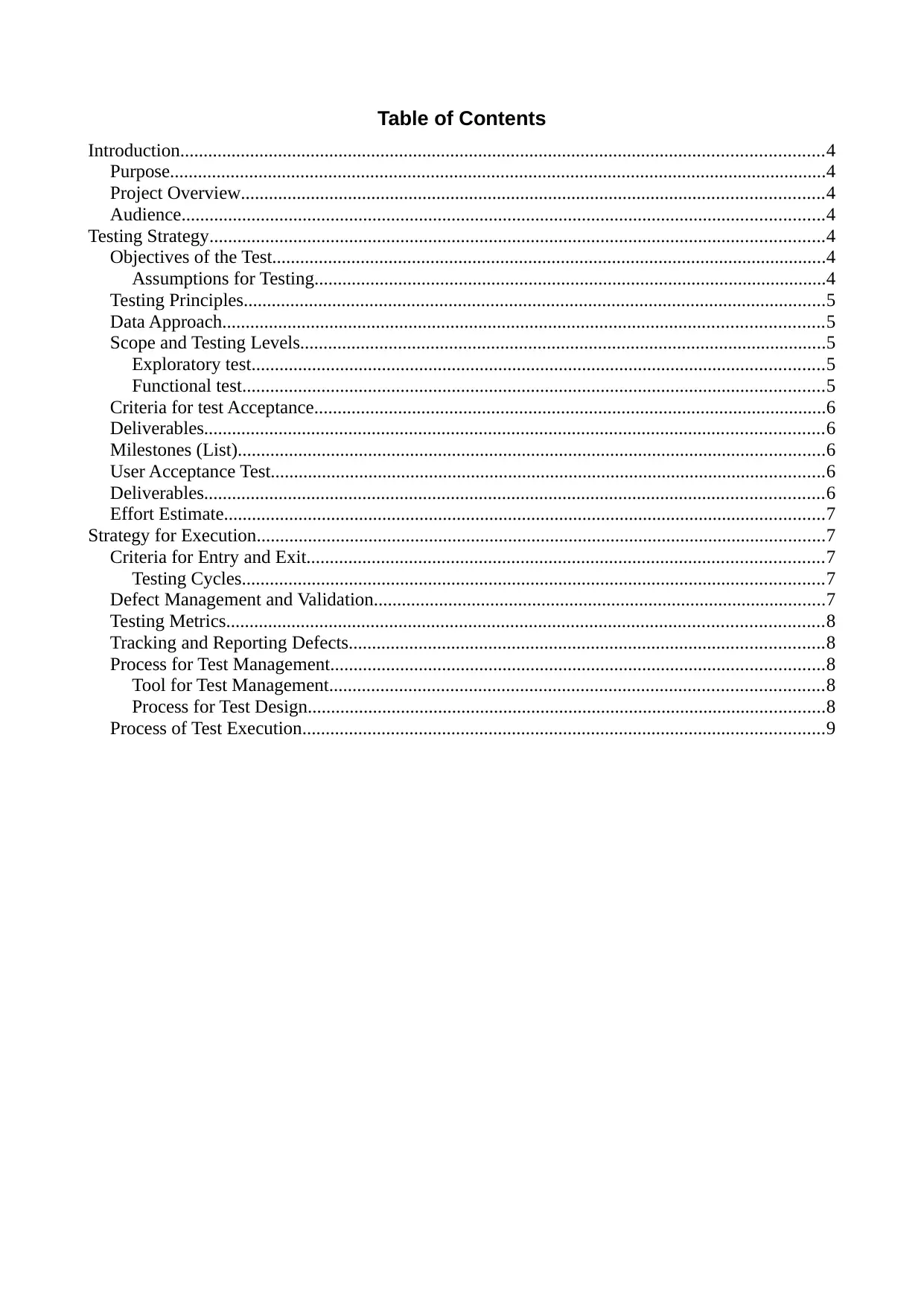
Table of Contents
Introduction..........................................................................................................................................4
Purpose.............................................................................................................................................4
Project Overview.............................................................................................................................4
Audience..........................................................................................................................................4
Testing Strategy....................................................................................................................................4
Objectives of the Test.......................................................................................................................4
Assumptions for Testing..............................................................................................................4
Testing Principles.............................................................................................................................5
Data Approach.................................................................................................................................5
Scope and Testing Levels.................................................................................................................5
Exploratory test...........................................................................................................................5
Functional test.............................................................................................................................5
Criteria for test Acceptance..............................................................................................................6
Deliverables.....................................................................................................................................6
Milestones (List)..............................................................................................................................6
User Acceptance Test.......................................................................................................................6
Deliverables.....................................................................................................................................6
Effort Estimate.................................................................................................................................7
Strategy for Execution..........................................................................................................................7
Criteria for Entry and Exit...............................................................................................................7
Testing Cycles.............................................................................................................................7
Defect Management and Validation.................................................................................................7
Testing Metrics................................................................................................................................8
Tracking and Reporting Defects......................................................................................................8
Process for Test Management..........................................................................................................8
Tool for Test Management..........................................................................................................8
Process for Test Design...............................................................................................................8
Process of Test Execution................................................................................................................9
Introduction..........................................................................................................................................4
Purpose.............................................................................................................................................4
Project Overview.............................................................................................................................4
Audience..........................................................................................................................................4
Testing Strategy....................................................................................................................................4
Objectives of the Test.......................................................................................................................4
Assumptions for Testing..............................................................................................................4
Testing Principles.............................................................................................................................5
Data Approach.................................................................................................................................5
Scope and Testing Levels.................................................................................................................5
Exploratory test...........................................................................................................................5
Functional test.............................................................................................................................5
Criteria for test Acceptance..............................................................................................................6
Deliverables.....................................................................................................................................6
Milestones (List)..............................................................................................................................6
User Acceptance Test.......................................................................................................................6
Deliverables.....................................................................................................................................6
Effort Estimate.................................................................................................................................7
Strategy for Execution..........................................................................................................................7
Criteria for Entry and Exit...............................................................................................................7
Testing Cycles.............................................................................................................................7
Defect Management and Validation.................................................................................................7
Testing Metrics................................................................................................................................8
Tracking and Reporting Defects......................................................................................................8
Process for Test Management..........................................................................................................8
Tool for Test Management..........................................................................................................8
Process for Test Design...............................................................................................................8
Process of Test Execution................................................................................................................9
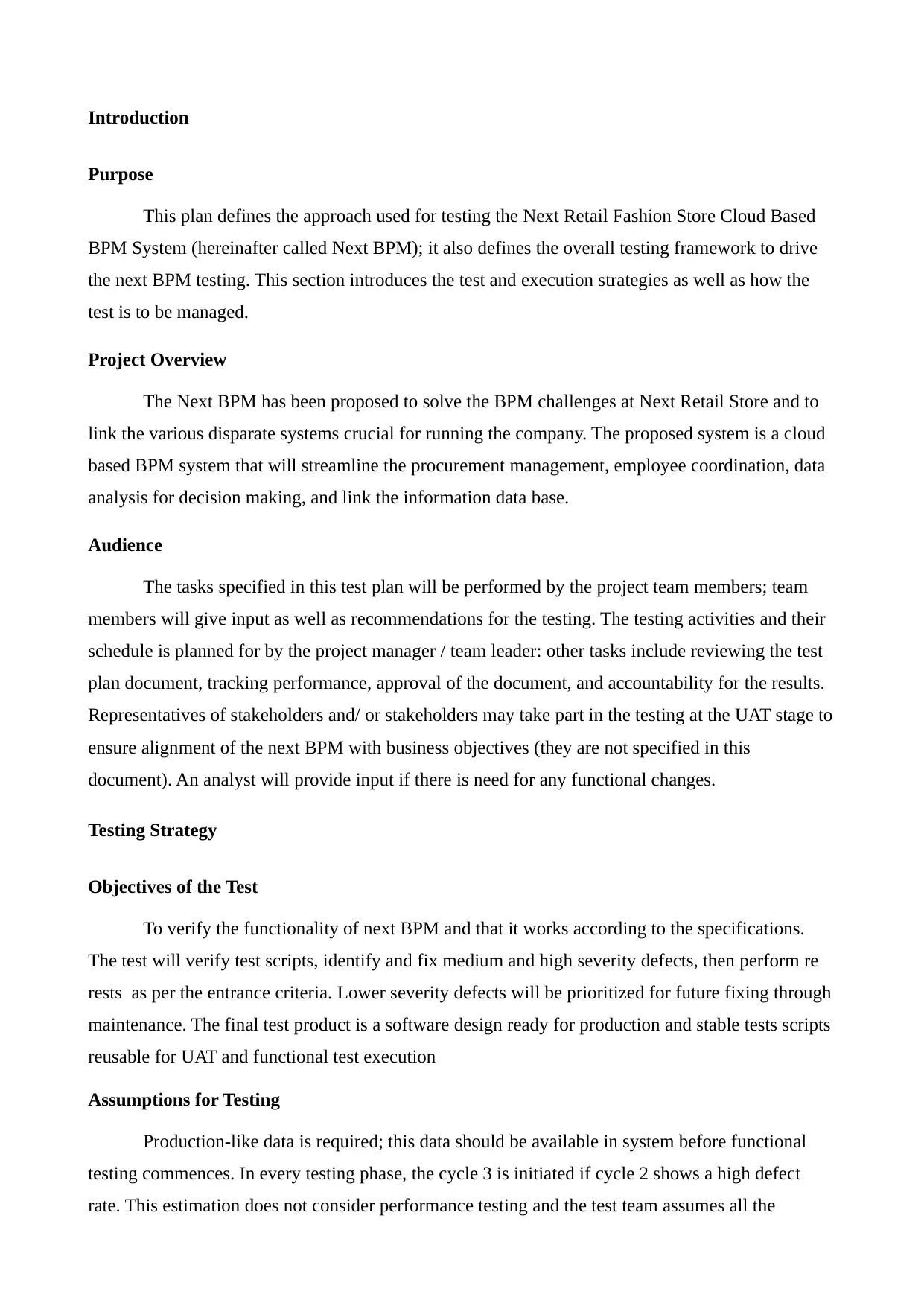
Introduction
Purpose
This plan defines the approach used for testing the Next Retail Fashion Store Cloud Based
BPM System (hereinafter called Next BPM); it also defines the overall testing framework to drive
the next BPM testing. This section introduces the test and execution strategies as well as how the
test is to be managed.
Project Overview
The Next BPM has been proposed to solve the BPM challenges at Next Retail Store and to
link the various disparate systems crucial for running the company. The proposed system is a cloud
based BPM system that will streamline the procurement management, employee coordination, data
analysis for decision making, and link the information data base.
Audience
The tasks specified in this test plan will be performed by the project team members; team
members will give input as well as recommendations for the testing. The testing activities and their
schedule is planned for by the project manager / team leader: other tasks include reviewing the test
plan document, tracking performance, approval of the document, and accountability for the results.
Representatives of stakeholders and/ or stakeholders may take part in the testing at the UAT stage to
ensure alignment of the next BPM with business objectives (they are not specified in this
document). An analyst will provide input if there is need for any functional changes.
Testing Strategy
Objectives of the Test
To verify the functionality of next BPM and that it works according to the specifications.
The test will verify test scripts, identify and fix medium and high severity defects, then perform re
rests as per the entrance criteria. Lower severity defects will be prioritized for future fixing through
maintenance. The final test product is a software design ready for production and stable tests scripts
reusable for UAT and functional test execution
Assumptions for Testing
Production-like data is required; this data should be available in system before functional
testing commences. In every testing phase, the cycle 3 is initiated if cycle 2 shows a high defect
rate. This estimation does not consider performance testing and the test team assumes all the
Purpose
This plan defines the approach used for testing the Next Retail Fashion Store Cloud Based
BPM System (hereinafter called Next BPM); it also defines the overall testing framework to drive
the next BPM testing. This section introduces the test and execution strategies as well as how the
test is to be managed.
Project Overview
The Next BPM has been proposed to solve the BPM challenges at Next Retail Store and to
link the various disparate systems crucial for running the company. The proposed system is a cloud
based BPM system that will streamline the procurement management, employee coordination, data
analysis for decision making, and link the information data base.
Audience
The tasks specified in this test plan will be performed by the project team members; team
members will give input as well as recommendations for the testing. The testing activities and their
schedule is planned for by the project manager / team leader: other tasks include reviewing the test
plan document, tracking performance, approval of the document, and accountability for the results.
Representatives of stakeholders and/ or stakeholders may take part in the testing at the UAT stage to
ensure alignment of the next BPM with business objectives (they are not specified in this
document). An analyst will provide input if there is need for any functional changes.
Testing Strategy
Objectives of the Test
To verify the functionality of next BPM and that it works according to the specifications.
The test will verify test scripts, identify and fix medium and high severity defects, then perform re
rests as per the entrance criteria. Lower severity defects will be prioritized for future fixing through
maintenance. The final test product is a software design ready for production and stable tests scripts
reusable for UAT and functional test execution
Assumptions for Testing
Production-like data is required; this data should be available in system before functional
testing commences. In every testing phase, the cycle 3 is initiated if cycle 2 shows a high defect
rate. This estimation does not consider performance testing and the test team assumes all the
Secure Best Marks with AI Grader
Need help grading? Try our AI Grader for instant feedback on your assignments.

required inputs during design for testing will be supported by developers and business analyst. All
sign-offs and deliverables to be reviewed by the analysts. The project team has the necessary
experience and knowledge in the testing process. No down times are expected during testing, for
instance, power outages. The team will perform functional testing while the end users (EU1, 2 and
3) will perform UAT testing.
Testing Principles
The focus of testing is to meet business objectives, quality, and cost efficiency
Common consistent procedures will be used by all teams that support the testing process
test procedures are clearly defined, flexible, and can change as needed with testing activities
building upon the preceding tests to avoid effort duplication or redundancy (Ellison, 2016).
A production environment is to be emulated as much as possible by the testing data and tests will
be quantifiable, repeatable, and measurable
Testing will be undertaken in distinct phases with each having clearly defined goals and
objectives and the testing has criteria for entrance and exit.
Data Approach
The Next BPM will have Pre-loaded testing data during functional testing
Scope and Testing Levels
Exploratory test
The purpose of the exploratory test is to ensure critical defects are removed before
subsequent testing levels can be undertaken
The scope of the test is navigation (first level), followed by administration, and user
modules
The testers are members of the project team and will be undertaken without test scripts or
documentation and will be done at the start of every testing cycle (Ellison, 2016)
Functional test
The purpose of the functional test is check application functions with input fed into the next
BPM and and output from the system validated.
The scope is to test the cloud based Next BPM and its performance when other systems,
based on design, are incorporated
Testing to be carried out by the project team and tests performed according to the functional
scripts; the functional test is undertaken at the end of the exploratory tests
sign-offs and deliverables to be reviewed by the analysts. The project team has the necessary
experience and knowledge in the testing process. No down times are expected during testing, for
instance, power outages. The team will perform functional testing while the end users (EU1, 2 and
3) will perform UAT testing.
Testing Principles
The focus of testing is to meet business objectives, quality, and cost efficiency
Common consistent procedures will be used by all teams that support the testing process
test procedures are clearly defined, flexible, and can change as needed with testing activities
building upon the preceding tests to avoid effort duplication or redundancy (Ellison, 2016).
A production environment is to be emulated as much as possible by the testing data and tests will
be quantifiable, repeatable, and measurable
Testing will be undertaken in distinct phases with each having clearly defined goals and
objectives and the testing has criteria for entrance and exit.
Data Approach
The Next BPM will have Pre-loaded testing data during functional testing
Scope and Testing Levels
Exploratory test
The purpose of the exploratory test is to ensure critical defects are removed before
subsequent testing levels can be undertaken
The scope of the test is navigation (first level), followed by administration, and user
modules
The testers are members of the project team and will be undertaken without test scripts or
documentation and will be done at the start of every testing cycle (Ellison, 2016)
Functional test
The purpose of the functional test is check application functions with input fed into the next
BPM and and output from the system validated.
The scope is to test the cloud based Next BPM and its performance when other systems,
based on design, are incorporated
Testing to be carried out by the project team and tests performed according to the functional
scripts; the functional test is undertaken at the end of the exploratory tests
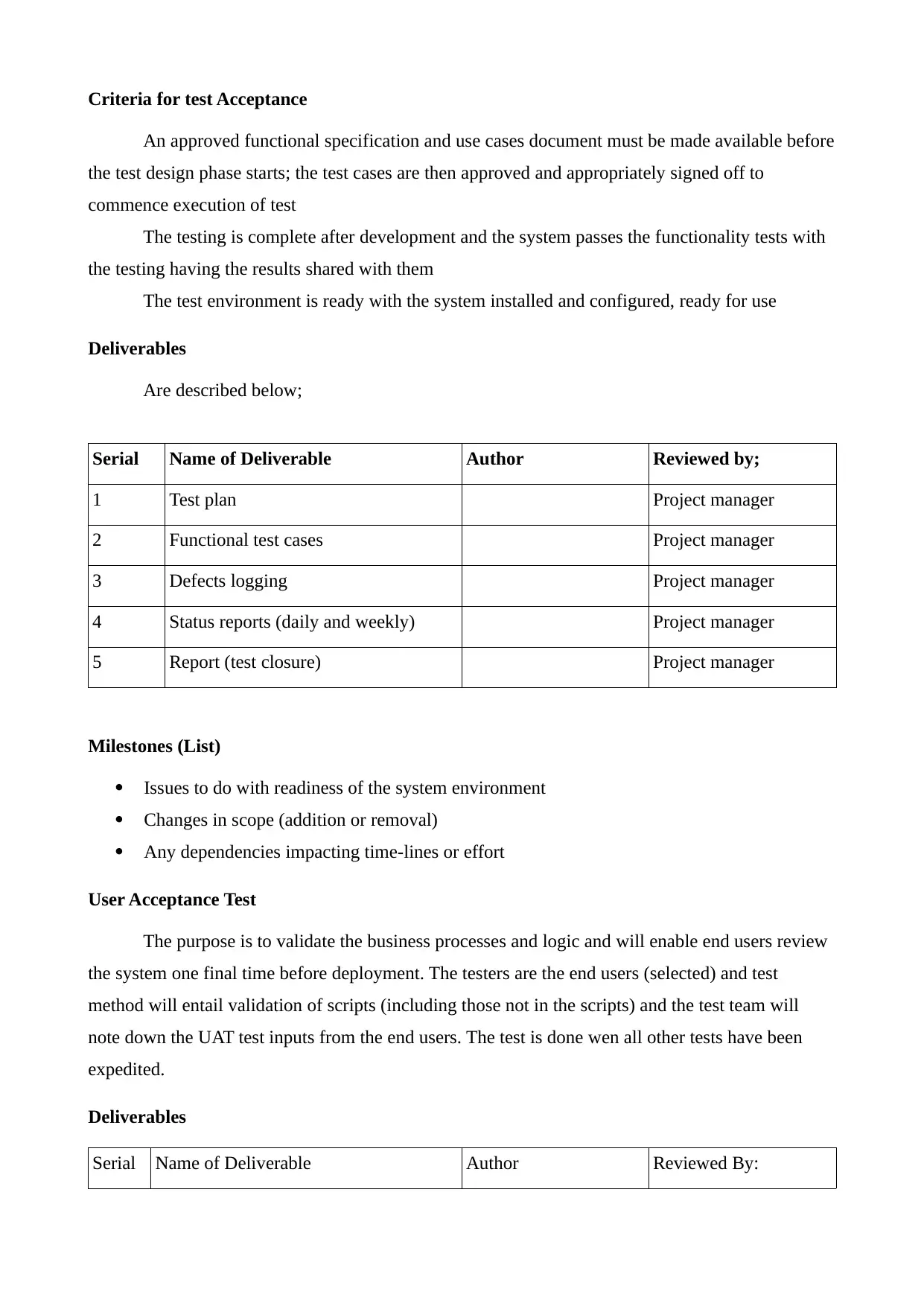
Criteria for test Acceptance
An approved functional specification and use cases document must be made available before
the test design phase starts; the test cases are then approved and appropriately signed off to
commence execution of test
The testing is complete after development and the system passes the functionality tests with
the testing having the results shared with them
The test environment is ready with the system installed and configured, ready for use
Deliverables
Are described below;
Serial Name of Deliverable Author Reviewed by;
1 Test plan Project manager
2 Functional test cases Project manager
3 Defects logging Project manager
4 Status reports (daily and weekly) Project manager
5 Report (test closure) Project manager
Milestones (List)
Issues to do with readiness of the system environment
Changes in scope (addition or removal)
Any dependencies impacting time-lines or effort
User Acceptance Test
The purpose is to validate the business processes and logic and will enable end users review
the system one final time before deployment. The testers are the end users (selected) and test
method will entail validation of scripts (including those not in the scripts) and the test team will
note down the UAT test inputs from the end users. The test is done wen all other tests have been
expedited.
Deliverables
Serial Name of Deliverable Author Reviewed By:
An approved functional specification and use cases document must be made available before
the test design phase starts; the test cases are then approved and appropriately signed off to
commence execution of test
The testing is complete after development and the system passes the functionality tests with
the testing having the results shared with them
The test environment is ready with the system installed and configured, ready for use
Deliverables
Are described below;
Serial Name of Deliverable Author Reviewed by;
1 Test plan Project manager
2 Functional test cases Project manager
3 Defects logging Project manager
4 Status reports (daily and weekly) Project manager
5 Report (test closure) Project manager
Milestones (List)
Issues to do with readiness of the system environment
Changes in scope (addition or removal)
Any dependencies impacting time-lines or effort
User Acceptance Test
The purpose is to validate the business processes and logic and will enable end users review
the system one final time before deployment. The testers are the end users (selected) and test
method will entail validation of scripts (including those not in the scripts) and the test team will
note down the UAT test inputs from the end users. The test is done wen all other tests have been
expedited.
Deliverables
Serial Name of Deliverable Author Reviewed By:

UAT Test Cases Project team Project manager
Effort Estimate
The testing will take 7 to 12 days, depending on outcomes
Strategy for Execution
Criteria for Entry and Exit
Entry criteria are the desirable conditions needed before tests can start and only migration
code and the fixes are assessed after every test cycle
Exit criteria are the desirable conditions to be met before proceeding with production and
deployment
The entry criteria pertains to having all activities in the test planning phase being 100%
completed
Exit criteria pertain ti having all activities in the test execution being 100% complete
Testing Cycles
Functional testing to have two cycles with all scripts executed in each cycle
The first cycle has the objective of identifying any critical defects, blocking, and majority of
the high defects and a work around will be used to get to all the scripts
The second cycle has the objective of identifying any remaining medium and high defects,
remove the work around from cycle one, correct gaps in scripts, and get performance results
There is one test cycle for UAT (Lewis & Dobbs, 2009
Defect Management and Validation
The team will execute all scripts in every cycle and if necessary, additional testing to be
done if there is a gap in the scripts, especially in the second cycle when the business analyst comes
in
The test results for each cycle will be used for defect tracking
The test team will open all defects, link them with their corresponding scripts or actions,
assign severity status, perform retests and close it. The project manager to review defects severity
and organize, with the technical team, how to fix the defects. The project manager will also
communicate when tests should proceed and when they ought to stop. The defects will be
categorized as shown below;
Effort Estimate
The testing will take 7 to 12 days, depending on outcomes
Strategy for Execution
Criteria for Entry and Exit
Entry criteria are the desirable conditions needed before tests can start and only migration
code and the fixes are assessed after every test cycle
Exit criteria are the desirable conditions to be met before proceeding with production and
deployment
The entry criteria pertains to having all activities in the test planning phase being 100%
completed
Exit criteria pertain ti having all activities in the test execution being 100% complete
Testing Cycles
Functional testing to have two cycles with all scripts executed in each cycle
The first cycle has the objective of identifying any critical defects, blocking, and majority of
the high defects and a work around will be used to get to all the scripts
The second cycle has the objective of identifying any remaining medium and high defects,
remove the work around from cycle one, correct gaps in scripts, and get performance results
There is one test cycle for UAT (Lewis & Dobbs, 2009
Defect Management and Validation
The team will execute all scripts in every cycle and if necessary, additional testing to be
done if there is a gap in the scripts, especially in the second cycle when the business analyst comes
in
The test results for each cycle will be used for defect tracking
The test team will open all defects, link them with their corresponding scripts or actions,
assign severity status, perform retests and close it. The project manager to review defects severity
and organize, with the technical team, how to fix the defects. The project manager will also
communicate when tests should proceed and when they ought to stop. The defects will be
categorized as shown below;
Paraphrase This Document
Need a fresh take? Get an instant paraphrase of this document with our AI Paraphraser
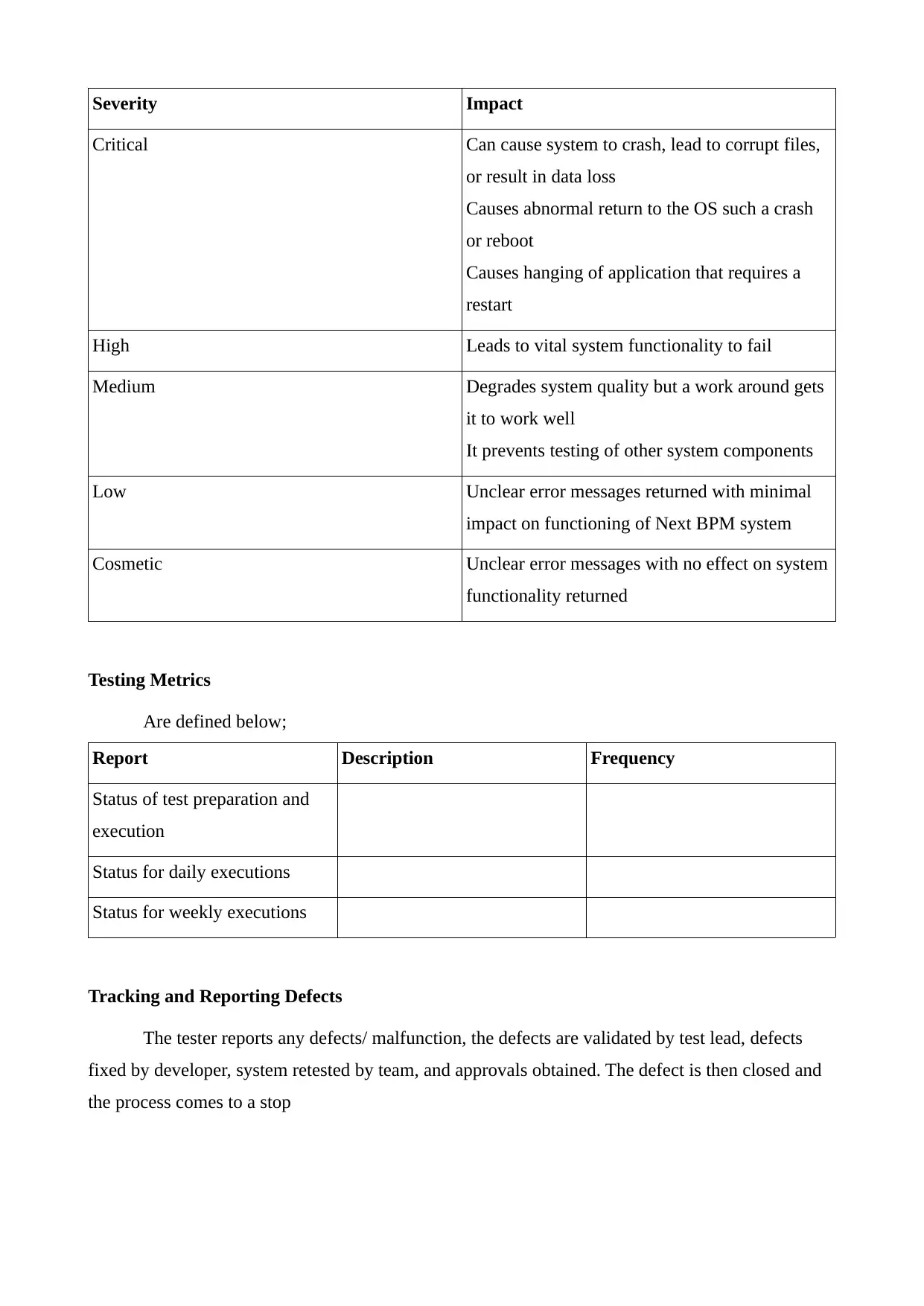
Severity Impact
Critical Can cause system to crash, lead to corrupt files,
or result in data loss
Causes abnormal return to the OS such a crash
or reboot
Causes hanging of application that requires a
restart
High Leads to vital system functionality to fail
Medium Degrades system quality but a work around gets
it to work well
It prevents testing of other system components
Low Unclear error messages returned with minimal
impact on functioning of Next BPM system
Cosmetic Unclear error messages with no effect on system
functionality returned
Testing Metrics
Are defined below;
Report Description Frequency
Status of test preparation and
execution
Status for daily executions
Status for weekly executions
Tracking and Reporting Defects
The tester reports any defects/ malfunction, the defects are validated by test lead, defects
fixed by developer, system retested by team, and approvals obtained. The defect is then closed and
the process comes to a stop
Critical Can cause system to crash, lead to corrupt files,
or result in data loss
Causes abnormal return to the OS such a crash
or reboot
Causes hanging of application that requires a
restart
High Leads to vital system functionality to fail
Medium Degrades system quality but a work around gets
it to work well
It prevents testing of other system components
Low Unclear error messages returned with minimal
impact on functioning of Next BPM system
Cosmetic Unclear error messages with no effect on system
functionality returned
Testing Metrics
Are defined below;
Report Description Frequency
Status of test preparation and
execution
Status for daily executions
Status for weekly executions
Tracking and Reporting Defects
The tester reports any defects/ malfunction, the defects are validated by test lead, defects
fixed by developer, system retested by team, and approvals obtained. The defect is then closed and
the process comes to a stop
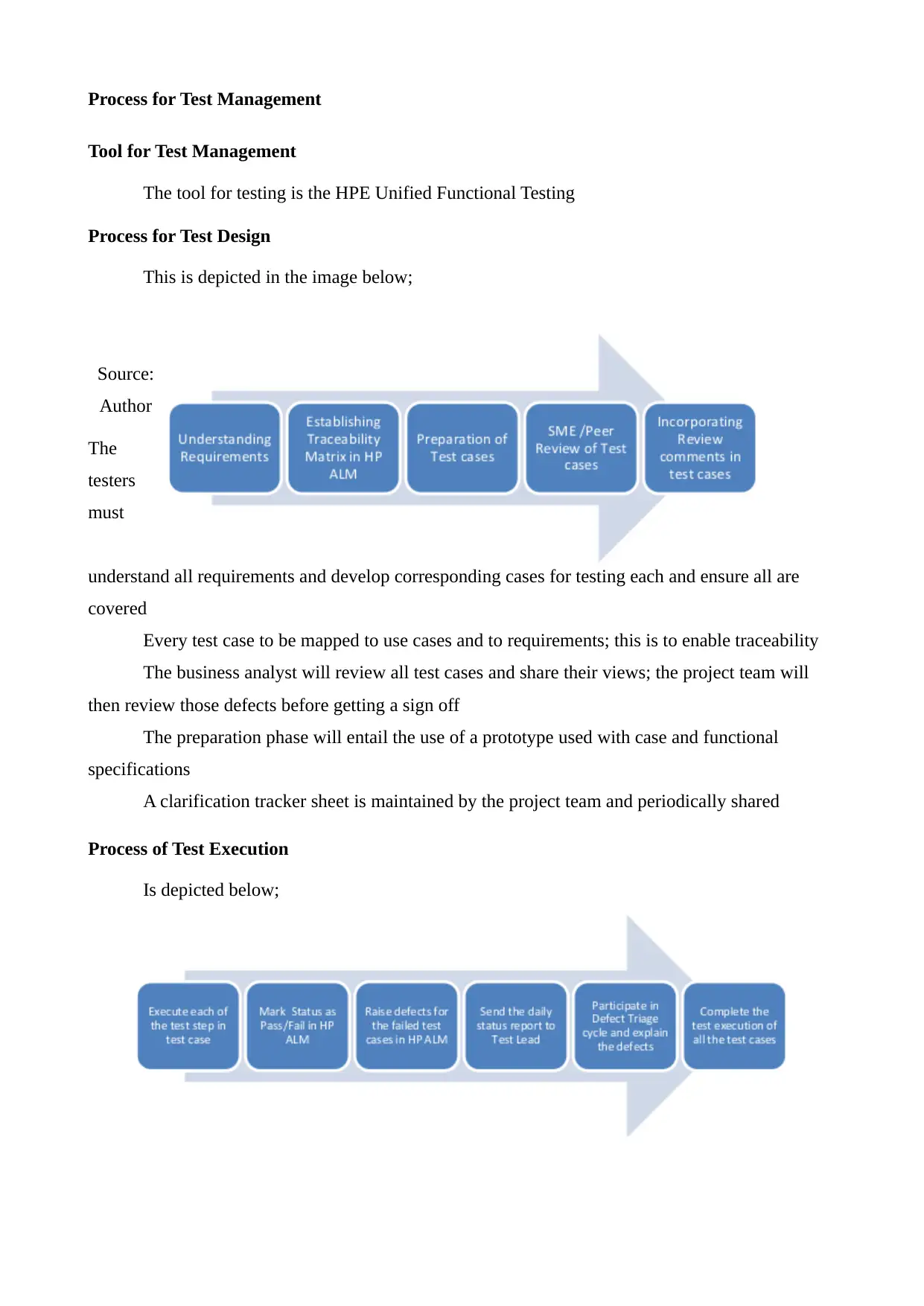
Process for Test Management
Tool for Test Management
The tool for testing is the HPE Unified Functional Testing
Process for Test Design
This is depicted in the image below;
Source:
Author
The
testers
must
understand all requirements and develop corresponding cases for testing each and ensure all are
covered
Every test case to be mapped to use cases and to requirements; this is to enable traceability
The business analyst will review all test cases and share their views; the project team will
then review those defects before getting a sign off
The preparation phase will entail the use of a prototype used with case and functional
specifications
A clarification tracker sheet is maintained by the project team and periodically shared
Process of Test Execution
Is depicted below;
Tool for Test Management
The tool for testing is the HPE Unified Functional Testing
Process for Test Design
This is depicted in the image below;
Source:
Author
The
testers
must
understand all requirements and develop corresponding cases for testing each and ensure all are
covered
Every test case to be mapped to use cases and to requirements; this is to enable traceability
The business analyst will review all test cases and share their views; the project team will
then review those defects before getting a sign off
The preparation phase will entail the use of a prototype used with case and functional
specifications
A clarification tracker sheet is maintained by the project team and periodically shared
Process of Test Execution
Is depicted below;
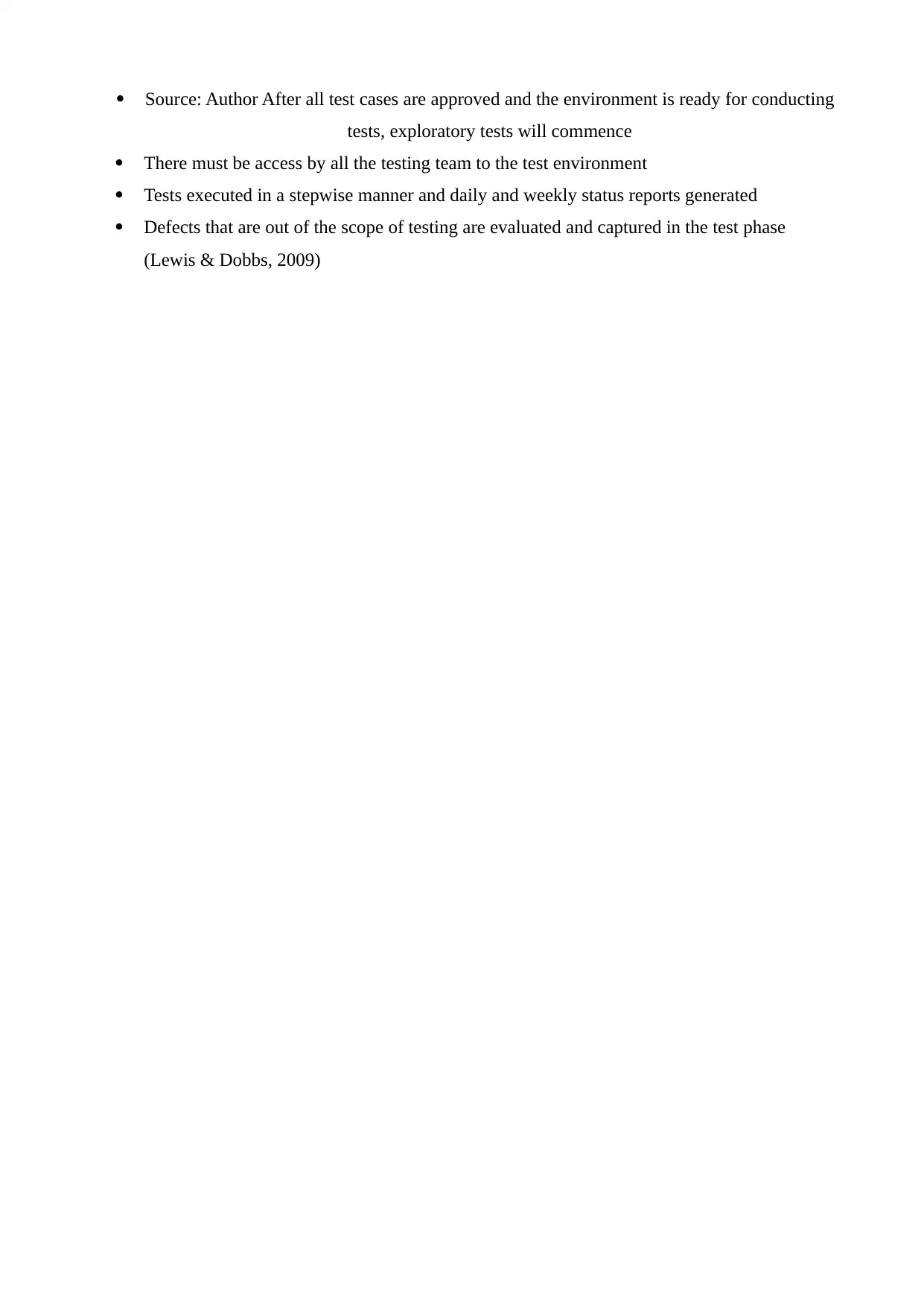
Source: Author After all test cases are approved and the environment is ready for conducting
tests, exploratory tests will commence
There must be access by all the testing team to the test environment
Tests executed in a stepwise manner and daily and weekly status reports generated
Defects that are out of the scope of testing are evaluated and captured in the test phase
(Lewis & Dobbs, 2009)
tests, exploratory tests will commence
There must be access by all the testing team to the test environment
Tests executed in a stepwise manner and daily and weekly status reports generated
Defects that are out of the scope of testing are evaluated and captured in the test phase
(Lewis & Dobbs, 2009)
1 out of 10
Related Documents
Your All-in-One AI-Powered Toolkit for Academic Success.
+13062052269
info@desklib.com
Available 24*7 on WhatsApp / Email
![[object Object]](/_next/static/media/star-bottom.7253800d.svg)
Unlock your academic potential
© 2024 | Zucol Services PVT LTD | All rights reserved.





